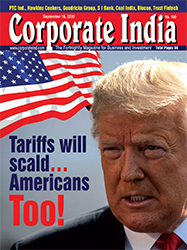Want to Subscribe?
Read Corporate India and add to your Business Intelligence

![]() Unlock Unlimited Access
Unlock Unlimited Access

Published: April 15, 2025
Updated: April 15, 2025
The Indian stock market, which had been on a downward trajec tory for several days in line with global market trends, witnessed a significant rebound on April 8. While such swings are not uncom mon in the volatile world of equity markets, they have left investors and analysts asking one crucial question: Is this a knee-jerk reaction to global uncertainties, or does this signify the beginning of a rever sal for the Indian market?

In recent weeks, the global stock market has been marked by volatility, with major indices in the United States, Europe and other developed markets seeing declines. This has been largely attributed to a mix of factors, including trade tensions, inflation concerns, ris ing interest rates and geopolitical uncertainties. In particular, the ongoing trade war between the US and China has sparked fears of a global economic slowdown, affecting investor sentiment world wide.
At the heart of the recent market downturns are concerns re garding US President Donald Trump’s tariffs on Chinese imports, which have had far-reach ing consequences on global trade and market performance. While Trump’s policies have sparked a sense of insecurity in global markets, the direct impact of these tariffs on the Indian stock market appears to be minimal at first glance.
India, despite its close economic ties with the US and China, has largely escaped the worst of the trade tensions. Indian exports to both countries account for a significant portion of the country’s GDP, but the nature of these exports and India’s relatively smaller exposure to Chi nese and US markets in comparison to other economies has shielded India to some extent.
However, the indirect effects of US tariffs on global trade cannot be ignored. As global trade slows down, demand for Indian goods and services may also dip, leading to weaker economic growth. Moreover, as global supply chains are disrupted, Indian companies with significant exposure to global markets may face rising costs, further affecting their profitability and stock prices.
These movements reflect a period of increased volatility, primarily driven by global trade tensions and their impact on investor sentiment. While both indices showed a rebound on April 8, the overall trend from April 2 to April 8 was downward, influenced by external economic factors.
Given India’s relatively limited exposure to the direct impacts of Trump’s tariffs, why are is the Indian stock market reacting so steeply to global developments? To understand this, we need to examine the broader factors driving investor sentiment in India.
When global markets face uncertainty, investors tend to seek safer assets, often moving away from equities and into bonds or precious metals like gold. This global risk aversion has led to significant sell-offs in equity markets around the world. Emerging markets, including India, are usually the first to feel the brunt of these sell-offs, as they are seen as riskier investments compared to developed markets.
While India may have avoided the direct impact of Trump’s tariffs, domestic economic concerns are starting to take centre-stage. Slow growth in key sectors such as manufacturing, agriculture and infrastructure is raising doubts about the overall health of the Indian economy. Rising inflation, coupled with stagnant wages, has further eroded purchasing power, leading to reduced consumer demand. This has, in turn, negatively im pacted corporate earnings, putting additional pressure on the stock market.
The Reserve Bank of India (RBI) has been under pressure to cut interest rates to stimulate economic growth. However, concerns about inflation and fiscal deficits have led to a more cautious approach in monetary policy, leaving investors uncertain about the central bank’s future actions. This uncertainty around interest rates and inflation expectations has contributed to the volatility in the stock market.
Another key reason for the recent steep reactions in the Indian market is the disappointment in corporate earnings reports. A number of large Indian companies have reported weaker-than-expected results, driven by both domestic and international chal lenges. Sluggish growth in key industries such as banking, real estate and consumer goods has raised concerns about the broader health of the economy, leading to a sell-off in stocks.
Geopolitical tensions in the form of border disputes, particu larly between India and Pakistan, and uncertainties surrounding regional stability have also weighed on investor sentiment. These risks have led to fears of capital flight, with foreign investors pulling their money out of India due to the perceived geopolitical instability.
While the recent sell-off in Indian markets has been sharp, it can be viewed as a knee-jerk reaction to the confluence of global and domestic factors. Equity markets, by their very nature, tend to over-react to both positive and negative news. The speed and magnitude of the recent decline in Indian stocks suggest that it was driven, in part, by panic selling and a short-term loss of confidence. However, it’s important to note that such market reactions are not entirely unusual in the current environment. The broader global markets have been experiencing similar volatility, with sharp swings in major indices across the US, Europe and Asia. Indian markets, being an integral part of the global financial system, have naturally mirrored this volatility. The rebound witnessed recently could very well be an indication of a market correction after a sharp fall. Investors, especially institutional players, often view such corrections as opportunities to buy undervalued stocks. This rebound could be a sign that the markets are beginning to find their footing and could be due for a recovery.
The question of whether the recent trend in the Indian stock market will continue or reverse in the coming weeks is not easy to answer. While the current market movements could suggest a reversal, there are several factors that will determine the course of the Indian market in the near term.
A key factor that could dictate the trend in the Indian market is the pace of recovery in global markets. If the trade tensions between the US and China ease, and if the global economy picks up steam, it could bolster investor confidence in emerging markets like India. A rebound in global demand, particularly in key sectors like technology, pharmaceuticals and manufacturing, could provide a much-needed boost to the Indian economy and, by extension, the stock market.
The health of the Indian economy will also play a signifi cant role in determining the future direction of the stock market. While growth has slowed down in recent months, there are signs of improvement in key areas like infrastructure spending, digitaliza tion and foreign direct investment. If these areas continue to show positive momentum, it could help lift the market from its recent lows.
The government’s fiscal policy and the RBI’s monetary policy will be crucial in determining the market’s trajectory. Any steps taken by the government to support growth, such as increased infrastructure spending or corporate tax cuts, could provide a lift to the stock market. Likewise, any further interest rate cuts or liquidity support from the RBI could encourage investor optimism.
Corporate earnings will continue to be a key driver of stock market performance. If companies can report better-than-expected earnings, it could spark renewed optimism in the market. Additionally, current market valuations are relatively attractive, with many stocks trading at lower multiples than their historical averages. This suggests that there may be room for upward movement if sentiment improves.
The geopolitical situation, particularly with respect to tensions in Kashmir and other regions, will also impact market sentiment. A stable political environ ment, coupled with measures to improve investor confidence, could lead to a gradual recovery in the market.
While the Indian stock market has shown signs of a rebound recently, it remains to be seen whether this marks the beginning of a sustained recovery or if further volatility lies ahead. The current correction may have been a knee-jerk reaction to a combination of global and domestic factors, but the longer-term trend will depend on the trajectory of the Indian economy and the global economic environment. For investors, it may be prudent to adopt a cautious, wait-and-see approach. While short-term volatility is inevitable, India’s long-term growth story remains intact. The country’s young popula tion, expanding middle class, and efforts to reform its economy provide a solid foundation for future growth. However, geopolitical risks, global trade uncertainties and domestic challenges will continue to influence market movements in the short term. As always, investors should remain focused on their long-term goals and consider diversification to mitigate risks during periods of market volatility. The road ahead may be rocky, but for those with a patient and strategic approach, there are opportunities to be had in India’s vibrant equity markets.

September 15, 2025 - First Issue

Industry Review

Want to Subscribe?
Read Corporate India and add to your Business Intelligence

![]() Unlock Unlimited Access
Unlock Unlimited Access
Lighter Vein

Popular Stories
Archives
